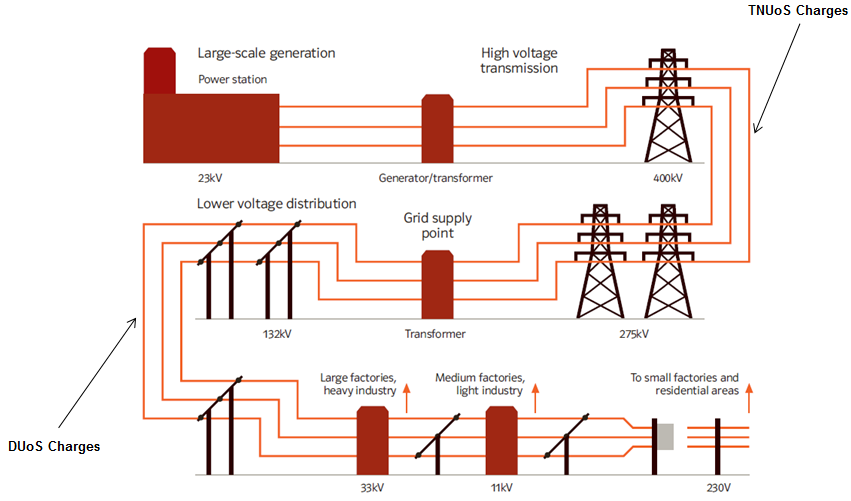Glossary
- TCMF
Transmission Charging Methodologies Forum
- TEC
Transmission Entry Capacity
- Time Pattern Regime
TPR- a TPR is a set of time intervals which define when a particular meter register is switch ON (i.e. recording consumption) and when it is switched OFF (i.e. not recording consumption). For example, a domestic Economy 7 customer is normally equipped with a metering system that is controlled by a time switch and has two registers: the ‘Low’ register and the ‘Normal’ register. If the ‘Low’ register records between 00:00 and 07:00 GMT each day, and the ‘Normal’ register records at other times:
The TPR for the ‘Low’ register consists of a single clock interval (00:00 – 07:00 GMT) repeated for every day; and
The TPR for the ‘Norma’ register also consists of a single clock interval (07:00 – 24:00) repeated for each day.
Meters have circuits and registers that are controlled by a Teleswitch receiver device which operates according to switching instructions broadcast on a particular Teleswitch channel by the CentralTeleswitch Control Unit. These instructions govern the switching behaviour of circuits and the registers controlled by the Teleswitch receiver. The technique enables the relays and registers of similar metering systems to be programmed remotely to follow the same daily switching regime. The Teleswitch instruction is represent a set of TPRs, each comprising a number of Teleswitch intervals (similar to clock intervals), that define the switching times for a particular settlement register.
- TISC
Trade and Industry Select Committee
- TLM
Transmission Loss Multiplier
- TNUoS
See Transmission Network Use of System Charges
- TO
Transmission Asset Owner
- Tolling Agreement
An agreement between a power buyer and a power generator, under which the buyer supplies the fuel and receives an amount of power generated based on an assumed heat rate at an agreed cost.
- Top Up and Standby
Arrangements for supply from other sources when the output of a local generator is either insufficient or if the generator is shut down.
- Top up Supply
The amount of electricity required by a generator when they do not generate sufficient electricity to meet the demands of all the consumers they are contracted to supply.
- TPR
Time Pattern Regime
- Traffic
Messages traversing the Data Transfer Network, which relates to Messages sent by Users.
- Transmission
The transfer of electricity at high voltage from generating stations across the UK through overhead lines and underground cables to points (GSP) from where it can distributed to users.
- Transmission Grid
The high voltage (HV) network that connects generating stations to the local distribution systems. In England and Wales this is owned by the National Grid Company, while in Scotland the transmission systems are owned by Scottish Power and Scottish and Southern Energy.
- Transmission Losses
As energy travels from the point of production to the end user, some of it is ‘lost’ on the system. Under the BSC arrangements there are two ways in which these losses are accounted for:
•Losses on the low voltage Distribution Networks are allocated through the use of Line Loss Factors (LLFs).
•Losses on the high voltage Transmission System are allocated across BSC Parties through the use of Transmission Loss Multipliers (TLMs).
Under the BSC arrangements Transmission Loss Multipliers (TLMs) are applied to BM Unit Metered Volumes as a means of scaling to account for losses on the Transmission System. The formulas for calculating Transmission Loss Multipliers are set out in BSC Section T, Paragraph 2.3.1.Historic Transmission Loss Multipliers data can be downloaded from the ELEXON Portal, as well as historic Estimated Transmission Loss Adjustment (ETLMOs), which are parameters set for the purposes of BMRS reporting.
Information:
http://www.elexon.co.uk/reference/technical-operations/losses/Data:
All data is published on the ELEXON Portal: https://www.elexonportal.co.uk- Transmission Network Use of System Charges
Transmission Network Use of System Charge (TNUoS). This covers the cost of using the National Transmission System, owned and operated by National Grid, to deliver electricity from power stations into and across the transmission network.
Consumers of electricity are split into two categories: half-hourly metered (HH) and non-half-hourly metered (NHH). Customers whose peak demand is sufficiently high are obliged to have a HH meter, which, in effect, takes a meter reading every 30 minutes. The rates at which charges are levied on these customers' electricity suppliers therefore varies 17,520 times a (non-leap-) year.
The TNUoS charges for a HH metered customer are based on their demand during three half hour periods of greatest demand between November and February, known as the Triad. Due to the nature of electricity demand in the UK, the three Triad periods always fall in the early evening, and must be separated by at least ten clear working days. The TNUoS charges for a HH customer are their average demand during the triad periods multiplied by the tariff for their zone.
TNUoS charges levied on NHH metered customers are much simpler. A supplier is charged for the sum of their total consumption between 16:00 and 19:00 every day over a year, multiplied by the relevant tariff.TNUoS Tariff can be found at:
https://www.nationalgrideso.com/charging/transmission-network-use-system-tnuos-charges
- Transmission Use of System
TUoS charges are raised by the National Grid to Suppliers for their use of the national grid transmission network. These charges are normally passed on to the customer as part of the unit price shown on the bill. In the case of Supply Only Billing (SOBS) the TUoS charges are shown separately to the Supply charges and can change during the contract period as they are reviewed annually.
- Triad
The three half hour periods of the highest demand on the transmission system, with at least 10 days between them, from the beginning of November in one year to the end of February in the following year.
- TSC
Time Switch Class
- TU
Trading Unit
- TUoS
See Transmission use of System
- TWh
Terawatt hours








